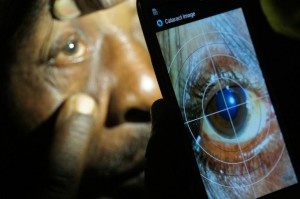In this article by Wired Magazine titled “ The Eye Doctor on Your Laptop Will See You Now”, the writer gives us, the audience, a glimpse into an online eye test by Opternative, a new online platform that gives users the opportunity to take free eye exams from the comfort of their homes. To employ Opternative for an eye test, he writes that all you need is “an internet connection, a smartphone a computer, and 25 minutes”. The eye exam is free for subscribers and provides glasses, contacts or both for a nifty price of $40 and $60 respectively.
The presence of Opternative marks a surging climb in online eye tests, and the platform’s 19,000 customer mark is a testimony to it’s success. The writer explains that Opternative’s relatively easy to use platform is one of the hallmarks of its success. Consumers are thrilled by the opportunity to go through a vision test at home, and it’s also free. This is how it works- Opternative texts users a link, and then acts as a coach, mentoring users through the online process. The platform asks users questions like “ which of these lines is sharper, the right one or left one?” This questioning process goes on for 25- 30 minutes, and the user must answer the question to best of their abilities. Once the user is done, the test results are reviewed by a doctor who looks for red flags and then sends a prescription. The user receives a signed copy with all the doctor’s information. All this sounds relatively easy, and possibly a better option for the consumer, but recent reports from the American Optometric Association might prove otherwise.
According to the AOA, Opternatives claims might be misleading and these claims, which the association describes as ambiguous, “could mislead patients into choosing convenience at the expense of proper eye and vision care.” Dr. Christopher Wolfe, a member of the AOA, and a reviewed a clinical study that Opternative uses to back its claim, comparing its vision test to an in-person refractive exam. The 30-person trial compared patients plano to -4.00 using spherical equivalent data for both exam modalities, determining a correlation. On Wolfe’s end, he discovered various discrepancies in the findings by Opternative, he concluded on the study and the platform noting that, “There are the eye health concerns that are obviously misleading, but the fact that the study they cite is so small and their claims that it points to accuracy and correlation to traditional refraction techniques is misleading at best, since it only accounts for spherical equivalent data.” The AOA will be taking several measures to advocate for the safeguarding of consumers against misleading claims made by various online vision tests. Already the federal government has taken action against one company, Carrot Neurotechnology, who’s online vision test proved to be deceitful towards consumers.
Information for this article is courtesy of Wired Magazine and the American Optometric Association. To follow on this issue, follow the American Optometric Association.

 Technology has truly come a long way in all aspects of our lives, especially in the field of medicine. Researches are rolling out a new app kit called “Peek” which allows to physicians to test a patients’ eyesight in remote areas around the world. Optometrists can use a smartphone device to conduct the tests, which have been proven to be just as accurate as the traditional letter chart we are all so familiar with.
Technology has truly come a long way in all aspects of our lives, especially in the field of medicine. Researches are rolling out a new app kit called “Peek” which allows to physicians to test a patients’ eyesight in remote areas around the world. Optometrists can use a smartphone device to conduct the tests, which have been proven to be just as accurate as the traditional letter chart we are all so familiar with.